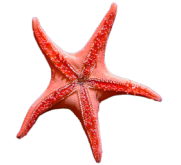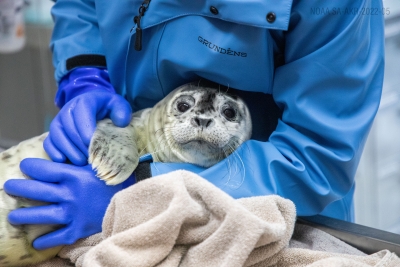Alaska SeaLife Center admits two additional harbor seal pups, one premature June 4, 2024
The Alaska SeaLife Center’s (ASLC) Wildlife Response Program now has three harbor seal pups under its care after the admit of two new patients — one female from Kachemak Bay on May 20, and another female from the Copper River Delta on May 27.
The first pup was spotted by kayakers near Bradley Lake power plant, and images identified it as a premature birth due to its white lanugo coat (typically shed in utero). Unfortunately, the pup’s location along mud flats would make access difficult for most boats — a situation compounded by a high wind advisory that day. After many hours on the phone with Homer water taxis and National Oceanic and Atmospheric Administration (NOAA) law enforcement, rescue attempts had to be called off. Two days later, the situation took a fortunate turn when a second party called with similar reports of a lanugo pup in the same area. Pictures sent matched those from the original call, leading staff to conclude it was likely the same seal. Because the party had a small skiff already beached in the area, they agreed to retrieve the seal and transport it from Kachemak Bay to Homer, where it was handed off to ASLC staff and transported back to Seward. This newest patient is the third lanugo pup to be admitted this season (the first of which died soon after admit due to challenges related to its premature birth, and the second of which remains under the care of wildlife response staff).
The second abandoned pup report came from a Cordova State Wildlife Trooper on behalf of a fleet of commercial fishermen. The fisherman reported that the seal had been seen without its mother for multiple days, and was beginning to appear exhausted. With permission from NOAA, a wildlife trooper landed a plane on a nearby beach and took possession of the seal to be transported to the ASLC. The pup stayed the night in Cordova, receiving supportive care from local medical personnel, before catching a flight to Anchorage the following day. The pup was then picked up by NOAA officials and handed off to ASLC wildlife response staff.
During their initial admit exams, both pups were found to be underweight and dehydrated, with the premature pup suffering additionally from malnourishment and several surface wounds. Because premature harbor seal pups have only about a 50% survival rate when admitted to a wildlife response program, delicate care will be necessary. The team is currently providing initial stabilizing treatments to both patients and keeping a close watch to ensure the best possible chance of survival. Updates will be shared on the ASLC’s Facebook and Instagram pages as they become available.
The Alaska SeaLife Center’s Wildlife Response Program can only provide care for stranded and injured marine animals with help from corporate sponsors and individual donors. The Center acknowledges the ongoing generous support of the Wildlife Response Program from supporters like ConocoPhillips Alaska, Marathon Petroleum Corporation, PetZoo, Partners 4 Wildlife, Matson, GCI, and a number of individual donors, funds, and foundations such as Stanley J Williams Fund and the Theresa Bannister Legacy Fund. Those interested in contributing to the care of these patients can visit the ASLC’s website: www.alaskasealife.org/donate.



